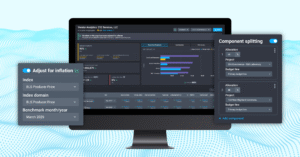The commercial real estate development industry, like many others, is being transformed by artificial intelligence (AI). The industry has a reputation for being slow to adopt new technologies, but Deloitte’s 2025 Real Estate Outlook survey reported 81% of real estate development identified data and AI technology as being a key area of spending for the year. In general, AI tools are expected to redefine nearly every stage of the development process, and organizations embracing technology will be at a distinct advantage over those stuck in a prior era.
Here’s a closer look at how AI is transforming the real estate development lifecycle and offering a competitive advantage to teams:
How AI Supports Real Estate Operations
AI plays a role across the commercial real estate development lifecycle, optimizing operations and boosting efficiencies. Use cases for AI and big data in real estate are numerous across the industry, from acquisitions through asset management. AI in particular has been a useful tool to gather and evaluate data to mitigate risk, allowing developers to address concerns in the development process before they develop into problems that derail your budget or project timeline.
1. From Legacy Systems to Automated Solutions
Industry leaders are finally beginning to turn away from inefficient manual processes and replace them with automated, data-driven strategies. AI is modernizing real estate, helping address modern concerns such as:
- Retaining top talent
- Securing capital amid slow deployment and market uncertainty
- Keeping costs in line as portfolios experience growth
You’ll reduce the amount of tedious manual data entry required, reducing the risk of error and opening your team members up to focus on strategic operations.
Developers should consider the best use cases for AI before implementing systems and consider how the technology can transform existing processes. Implementing AI is about streamlining and elevating workflows, gaining maximal benefits along the way. AI is often an intuitive tool, and having a plan to train all members of your firm will help with adoption. You can work with your team to build a plan for how AI will be integrated at your firm, and then create a roadmap for your goals for how the technology will improve the company. Be ready to have a plan to boost data security and ensure your team feels comfortable with a secure and ethical use of AI.
When your team is aligned on how AI supports your business strategy, you’ll see smoother adoption and more immediate benefits from it too. In the current market – with market uncertainty, supply chain concerns, and talent shortages – your team will greatly benefit from having a competitive advantage.
2. Streamlining Market Analysis and Predictive Analytics
Market research is a vital part of the due diligence process, and AI’s ability to process large amounts of data provides stronger market insights, crunching numbers on economic conditions, property values, and other demographics. Real estate data analytics can also provide predictive insights into market trends, tenant needs, and construction costs using real time data. Investors and developers can then use the data to identify emerging opportunities, flag undervalued assets, and adjust portfolio planning to meet demand.
AI can leverage past and present market data to:
- Predict future demand
- Help developers make informed decisions about project size and timing
- Help make strategic decisions taking factors into consideration such as location, site size, and accessibility
Incorporating AI into your due diligence process you’ll identify potential issues in the acquisition process before resources and time are before investing resources or projects.
3. AI-Driven Budgeting and Scope Gap Prevention
Modern real estate development software with AI capability can help users gain critical insights to keep budgets lean and eliminate any guesswork from the vendor selection process. AI Budget Optimizer functionality estimates how much money you can save based on data from an ever-expanding database of vendors. AI can also help recommend vendors who, based on data and timing, are primed to bid low.
Your firm can use AI and automation to boost employee efficiency at every stage of the development process, eliminating the need for tedious and time-consuming administrative tasks. Project management software with AI capabilities automatically capture and organize every project document, extracting data and organizing across budget lines to track and flag any errors before getting out of control.
Once data is tagged and indexed, you can quickly and easily search contracts, proposals, or other documentation to make data-driven decisions. Eliminating the need for manual entry allows your development and accounting teams to focus on important tasks and high-level decision-making. AI and machine learning in real estate investment tracks budgets in real-time, prevents overruns, addresses scope gaps, and achieves faster project delivery.
4. Risk Assessment, Mitigation, and Compliance
AI can play a key role in transforming operations in the real estate industry, shifting how your firm can detect fraud, anomalies, and compliance risks in your contracts and transactions. The technology not only boosts efficiency by automating the capture and processing of documents and data, it can also identify any anomalies or potential risks so your team can address them before the issue escalates. Your team will can a critical advantage by having access to proactive insights that help you
The many capabilities of AI mean it can be a powerful tool for risk assessment and mitigation on a given project. Investors and developers are relying on AI to manage portfolios, identify potential risks, and make data-driven decisions about property acquisitions and financing. AI can analyze market trends, historical data, and real-time inputs to forecast potential cost overruns, and uncover discrepancies in vendor performance or your budget.
AI can proactively assess and flag risks associated with the different stages of a development project, such as construction delay and economic turbulence. Development teams can address these concerns before they become a major concern that could disrupt project timelines or cause overruns. Your team can enable real time insights and early warnings to allow project managers to implement contingency plans, reallocate resources, and renegotiate terms as necessary.
How AI Enhances Stakeholder Experience
Modern real estate development software can play an important role in aligning your stakeholders, centralizing key project data and facilitating smoother reporting or communication. AI can further enhance stakeholder experience, ensuring accurate communication, streamlining processes, and automating reporting tasks. Opting for an AI-driven tool can increase stakeholder transparency by maximizing transparency with real-time and up-to-date information. AI can also help foster collaboration by fostering shared sense of ownership and buy-in.
If your platform can segment out stakeholders based on role, you’ll be able to tailor communications to better address the needs of stakeholders. By leveraging AI-powered tools, you can also sort stakeholder comments by sentiment, urgency, or relevance. As a result, you’ll be able to ensure concerns from investors, vendors, or other relevant parties can be addressed in a timely manner. Overall, AI can lead to better project outcomes and stronger stakeholder relationships that bolster your firm’s reputation.
Automated Valuation Tools for Investors
AI applications in real estate can improve valuation accuracy and reduce risk by leveraging historical data and marking trends. Data analytics in property development can be gathered to make more informed decisions in early project planning. Property market data, such as overall conditions, supply-and-demand dynamics, rental or vacancy rates, or absorption rates, can help your team make appropriate decisions for when to invest in a project. Project data from current and past projects can also lead to smarter decisions in early planning or procurement, and this data will also lead to fewer overruns and procurement issues in the long run.
AI-Powered Communication and Collaboration For Teams
AI dashboards improve communication among lenders, contractors, and project managers for aligned, efficient teamwork. Modern real estate development software can aggregate, analyze, and compare data across your portfolio. AI budget categorizations let you organize projects differently and still set meaningful portfolio benchmarks that enable scaling and other strategic planning. Proptech solutions are supercharging communication, preventing siloed workflows, and ensuring a more enjoyable collaborative experience for everyone.
Ethical and Responsible AI Practices
Implementing ethical and responsible AI applications in real estate is essential for your firm to build trust, maintain regulatory compliance, and promote long-term sustainability. When AI is used for investment decisions, your firm should still have an understanding of how data is being leveraged for the sake of transparency. Firms should also establish clear structures around AI usage, so employees understand the roles and responsibilities more clearly.
Data Privacy & Compliance
As commercial real estate developers adopt AI solutions, understanding the regulatory landscape becomes increasingly important. Understanding responsible artificial intelligence in real estate practices for data security, privacy, and compliance is essential as you leverage the technology to automate your development processes. From data privacy to fair housing considerations, AI implementation must be approached with compliance in mind.
Data Privacy Essentials
- AI systems in real estate must adhere to GDPR, CCPA, and other data protection regulations when handling sensitive project information
- Commercial developers should understand disclosure requirements, especially when AI analyzes personal or financial data
- Tenant, investor, and contractor data must be protected through appropriate security measures
Regulatory Bodies & Industry Standards
- Several organizations provide guidelines for ethical AI implementation in commercial real estate:
- The SEC has established disclosure requirements for AI-driven financial projections
- Local building and zoning boards increasingly review AI-generated models and analytics
- Industry associations like ULI and NAIOP offer best practices for technology implementation
Mitigating Bias in AI Algorithms
In order to mitigate bias and build stakeholder trust through transparent AI use, you’ll need to ensure data sets are high-quality, diverse, and representative. Bias often occurs in AI algorithms when data is incomplete or skewed, such as when property values are skewed or market data is out of date. Developers should regularly audit AI models and incorporate fairness metrics to keep models strong and bolder the integrity of outcomes. Prioritizing transparency around how AI is being used and implemented can also help establish stakeholder trust. The ability to provide stakeholders visibility into where data is being sourced from, the goals of your AI modeling, and how your team responsibly incorporates AI predictions or forecasting into operations will go a long way in terms of mitigating bias and bolstering trust.
Northspyre’s AI Advantage
AI can help your development team lower bidding costs, eliminate scope gaps, and remove the guesswork so you can maximize your profits. Modeled with over $175 billion in real estate development projects and hundreds of thousands of project documents, Northspyre AI’s predictive algorithm enables developers to cut costs and refine their budget as early as the pre-development phase. Users of Northspyre’s bidding platform can harness generative AI to review incoming bids from vendors and identify any missing scope or scope gaps.
Northspyre is an end-to-end development platform designed using automation to reduce manual data entry, increase productivity, and maximize your returns from pre-development to project completion. The platform gives you the insights and analytics you need to identify patterns, evaluate performance, and optimize and improve across your portfolio. This includes analytics for project teams, costs, budget lines, vendors, schedules, and more. AI capability extracts key insights from incoming project documents and indexes that information as searchable data.
Future Real Estate AI Trends and Innovations
AI is continuing to evolve, and several key trends are likely to lead the future of AI and big data in real estate. Here’s a closer look at where innovations will continue to drive the industry forward, and how it might impact your firm’s operations.
Property Valuations
Property appraisals have traditionally relied on manual entry and analysis, making them time-consuming and prone to errors. AI powered algorithms are going to completely transform this process by analyzing data sets, such as historical sales, property conditions, neighborhood dynamics, and more to provide accurate and unbiased predictions. Automated Valuation Models (AVMs) that analyze extensive data sets are going to continue to deliver accurate and consistent property valuations and upend the traditional valuation process.
Predictive Analytics
AI-powered predictive analytics will continue to be important as a medium to forecasts market shifts, predict housing demand, and identify emerging opportunities based on market trend.
Automated Transaction Process
AI is going to streamline and expedite the transaction process, from paperwork to due diligence, making moving deals through the pipeline more efficient. The ability to streamline financial feasibility analysis, teams will be able to identify the highest and best use cases across the development pipeline.
Integrated Project Delivery with AI
Real estate marketing trends will also be transformed by integrated project delivery with AI. For example, owners may rely more on adaptive design, where AI leverages user behavior, market data, and demographic insights to dynamically personalize property layouts, amenities, and marketing materials based on target buyer or tenant profiles. The customized user experience will help boost conversion and retainment rate for property owners. AI-powered contract management will also automate the drafting, review, and tracking of contracts with greater accuracy and speed.
Sustainability and Green Building Advancements
AI supports sustainability goals, green certifications, and energy efficiency in CRE projects by optimizing building energy use through smart systems and predictive analytics. The technology can be used to help obtain green building certifications by compiling reports to facilitate the compliance process, and enhance resource efficiency in water management and waste reduction. Leveraging machine learning and data driven insights, building owners are also able to model, analyze, and predict energy consumption, retrofit costs, and evaluate the impacts of building upgrades.
Learn more about Northspyre
Northspyre is an end-to-end single software solution designed using automation to reduce manual data entry, increase productivity, and maximize your returns from pre-development to project completion. The platform enables you and your teams to ensure every aspect of your project is readily at your fingertips for simple and effective project management. Catering to development teams of all shapes and sizes, Northspyre can help you reduce administrative tasks by up to 80% and lower your project overruns by up to 66%.
Book a demo and learn how Northspyre can help your team leverage AI capabilities to transform how your development team works and make smarter decisions from acquisition through stabilization.



